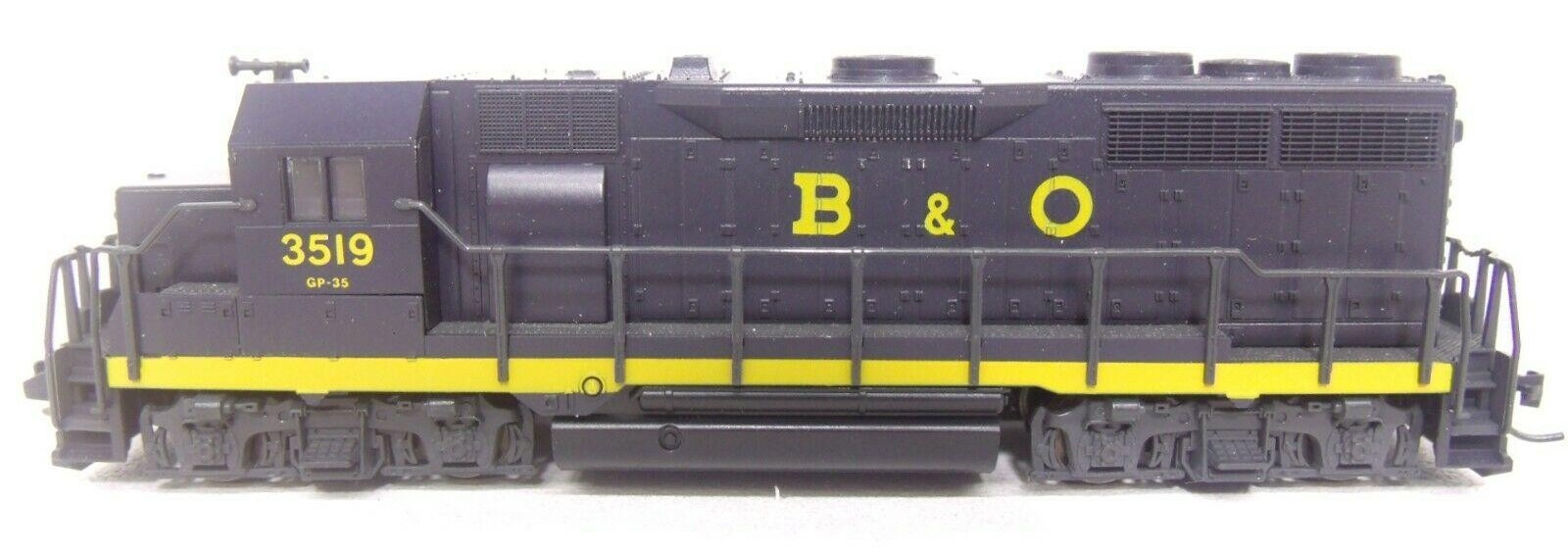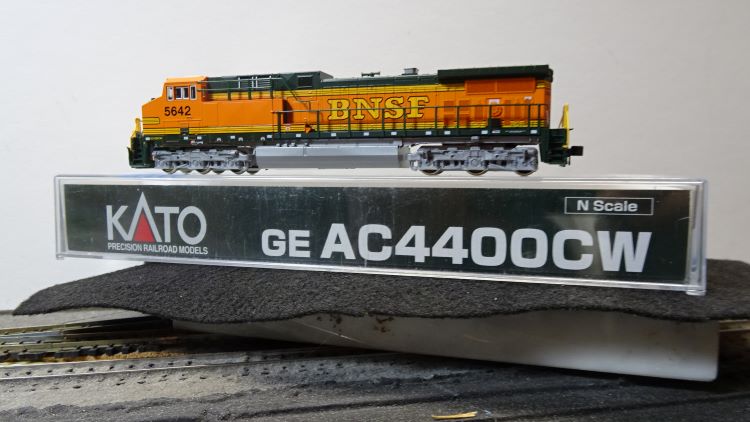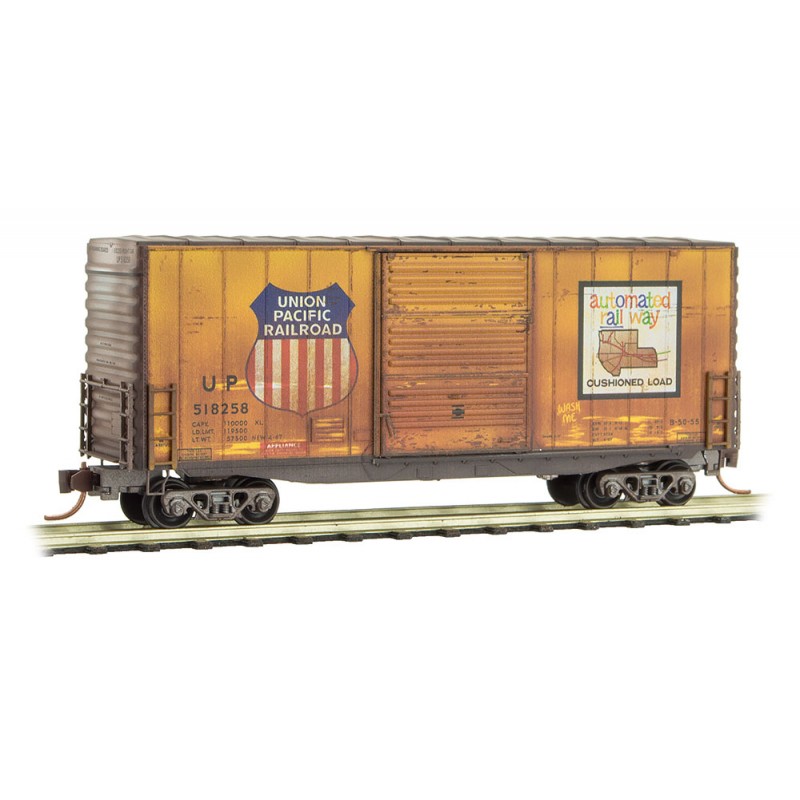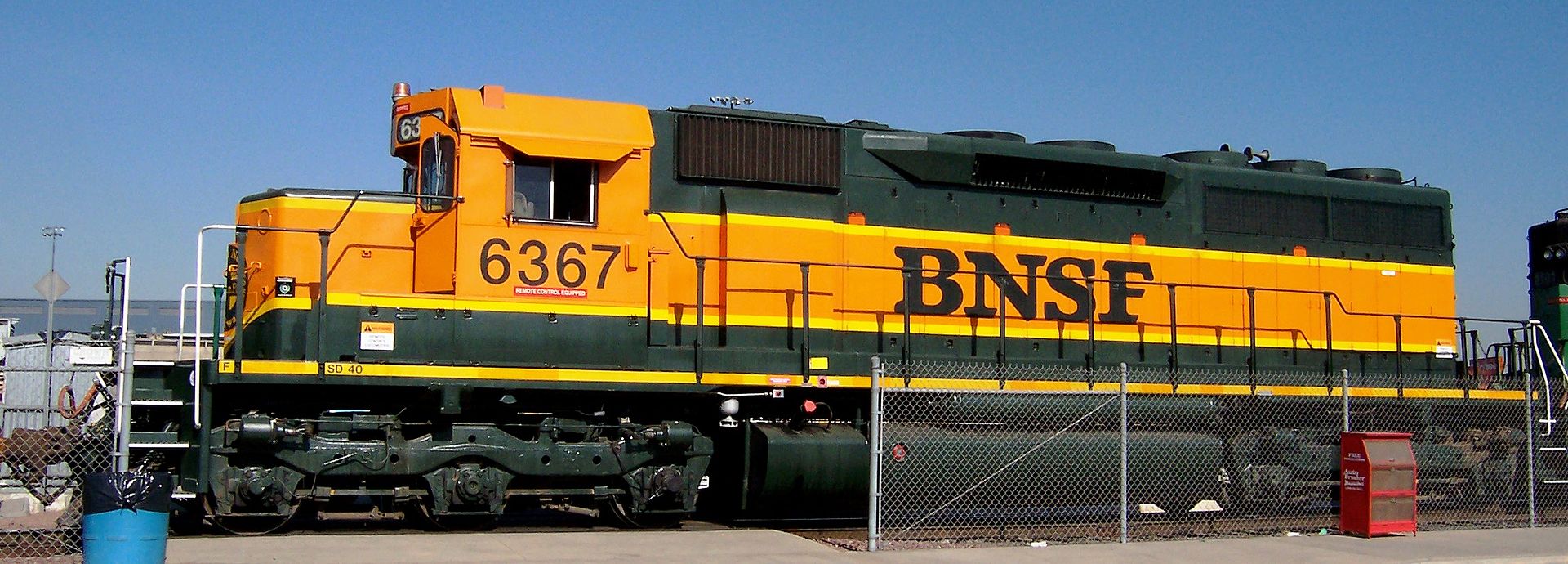Model Information: Kato introduced this '2nd generation" SD40 model in 1991. Later, in 1995, they started producing SD45s with the same mechanism. In 2002 they revised an re-released the SD40. In 2010 revised and re-released the SD45.
When it first came out, the Kato 1991 SD40 was considered very innovative for its time. The model features full pilots with body-mounted couplers. These models (both pre and post revision) run very well with excellent all-wheel pickup and drive. They are quiet and smooth running (though quite fast compared to new Atlas slow-speed mechanisms). They can really pull and handle fairly well on sharp curves. The key difference between the early and later version of the mechanism is the DCC support.
When it first came out, the Kato 1991 SD40 was considered very innovative for its time. The model features full pilots with body-mounted couplers. These models (both pre and post revision) run very well with excellent all-wheel pickup and drive. They are quiet and smooth running (though quite fast compared to new Atlas slow-speed mechanisms). They can really pull and handle fairly well on sharp curves. The key difference between the early and later version of the mechanism is the DCC support.
DCC Information: The early versions (pre-2002) are considered DCC-friendly. The later revisions support drop-in decoders. I suspect that it is easier and cheaper to take one of the old shells and drop it over a new chassis than to try to convert an old mechanism to DCC.
Prototype History: The EMD SD40 is a 6-axle road switcher diesel-electric locomotive built by General Motors Electro-Motive Division between January 1966 and August 1972. In 1966, EMD updated its locomotive catalog with entirely new models, all powered by the new 645 diesel engine. These included six-axle models SD38, SD40, SDP40 and SD45. All shared standardized components, including the frame, cab, generator, trucks, traction motors, and air brakes. The primary difference was the power output, with SD40 being rated at 3,000 hp (2,240 kW) from a turbocharged V16.
856 examples of this locomotive model were built for American railroads, 330 were built for Canadian railroads, 72 were built for Mexican railroads, 6 were built for the Guinea-Boke Project, and 4 SD40Ms riding on 5 ft 3 in (1,600 mm) gauge trucks were exported to Brazil.
From Wikipedia
Read more on American-Rails.com
Full SD40 data sheet on The Diesel Shop.
856 examples of this locomotive model were built for American railroads, 330 were built for Canadian railroads, 72 were built for Mexican railroads, 6 were built for the Guinea-Boke Project, and 4 SD40Ms riding on 5 ft 3 in (1,600 mm) gauge trucks were exported to Brazil.
From Wikipedia
Read more on American-Rails.com
Full SD40 data sheet on The Diesel Shop.
Road Name History: Chessie System, Inc. was a holding company that owned the Chesapeake & Ohio Railway (C&O), the Baltimore & Ohio Railroad (B&O), the Western Maryland Railway (WM), and several smaller carriers. It was incorporated in Virginia on February 26, 1973, and it acquired the C&O (which controlled the other companies) on June 15. C&O had been popularly known as "Chessie System" since the 1930s.
The three railroads had been closely related since the 1960s. C&O had acquired controlling interest in B&O in 1962, and the two had jointly controlled WM since 1967.
On November 1, 1980, Chessie System merged with Seaboard Coast Line Industries to form CSX Corporation. However, the Chessie image continued to be applied to new and re-painted equipment until mid-1986, when CSX introduced its own paint scheme. The B&O and C&O were not legally merged out of existence until 1987, when the company's official successor, CSX Transportation was founded.
Headquartered in Cleveland, Ohio, the Chessie System was the creation of Cyrus S. Eaton and his prot?g? Hays T. Watkins, Jr., then president and chief executive officer of C&O. A chief source of revenue for the Chessie System was coal mined in West Virginia. Another was the transport of auto parts and finished motor vehicles.
The signature symbol of the Chessie System was its "Ches-C", a large emblem incorporating the outline of the C&O's famous "Chessie" the kitten logo. The Ches-C was emblazoned on the front of all Chessie System locomotives, and also served as the "C" in "Chessie System" on the locomotive's flanks, and on other rolling stock. The Chessie System itself did not own any locomotives or other rolling stock; rather, equipment would be placed on the roster of one of the three component railroads. While all three companies shared a common paint scheme of yellow, vermillion, and blue, actual ownership of the equipment was denoted by the reporting marks C&O, B&O, or WM.
From Wikipedia
The three railroads had been closely related since the 1960s. C&O had acquired controlling interest in B&O in 1962, and the two had jointly controlled WM since 1967.
On November 1, 1980, Chessie System merged with Seaboard Coast Line Industries to form CSX Corporation. However, the Chessie image continued to be applied to new and re-painted equipment until mid-1986, when CSX introduced its own paint scheme. The B&O and C&O were not legally merged out of existence until 1987, when the company's official successor, CSX Transportation was founded.
Headquartered in Cleveland, Ohio, the Chessie System was the creation of Cyrus S. Eaton and his prot?g? Hays T. Watkins, Jr., then president and chief executive officer of C&O. A chief source of revenue for the Chessie System was coal mined in West Virginia. Another was the transport of auto parts and finished motor vehicles.
The signature symbol of the Chessie System was its "Ches-C", a large emblem incorporating the outline of the C&O's famous "Chessie" the kitten logo. The Ches-C was emblazoned on the front of all Chessie System locomotives, and also served as the "C" in "Chessie System" on the locomotive's flanks, and on other rolling stock. The Chessie System itself did not own any locomotives or other rolling stock; rather, equipment would be placed on the roster of one of the three component railroads. While all three companies shared a common paint scheme of yellow, vermillion, and blue, actual ownership of the equipment was denoted by the reporting marks C&O, B&O, or WM.
From Wikipedia
Brand/Importer Information: KATO U.S.A. was established in 1986, with the first U.S. locomotive model (the GP38-2, in N-Scale) released in 1987. Since that time, KATO has come to be known as one of the leading manufacturers of precision railroad products for the modeling community. KATO's parent company, Sekisui Kinzoku Co., Ltd., is headquartered in Tokyo, Japan.
In addition to producing ready-to-run HO and N scale models that are universally hailed for their high level of detail, craftsmanship and operation, KATO also manufactures UNITRACK. UNITRACK is the finest rail & roadbed modular track system available to modelers today. With the track and roadbed integrated into a single piece, UNITRACK features a nickel-silver rail and a realistic-looking roadbed. Patented UNIJOINERS allow sections to be snapped together quickly and securely, time after time if necessary.
The Kato U.S.A. office and warehouse facility is located in Schaumburg, Illinois, approximately 30 miles northwest of Chicago. All research & development of new North American products is performed here, in addition to the sales and distribution of merchandise to a vast network of wholesale representatives and retail dealers. Models requiring service sent in by hobbyists are usually attended to at this location as well. The manufacturing of all KATO products is performed in Japan.
Supporters of KATO should note that there is currently no showroom or operating exhibit of models at the Schaumburg facility. Furthermore, model parts are the only merchandise sold directly to consumers. (Please view the Parts Catalog of this website for more specific information.)
In addition to producing ready-to-run HO and N scale models that are universally hailed for their high level of detail, craftsmanship and operation, KATO also manufactures UNITRACK. UNITRACK is the finest rail & roadbed modular track system available to modelers today. With the track and roadbed integrated into a single piece, UNITRACK features a nickel-silver rail and a realistic-looking roadbed. Patented UNIJOINERS allow sections to be snapped together quickly and securely, time after time if necessary.
The Kato U.S.A. office and warehouse facility is located in Schaumburg, Illinois, approximately 30 miles northwest of Chicago. All research & development of new North American products is performed here, in addition to the sales and distribution of merchandise to a vast network of wholesale representatives and retail dealers. Models requiring service sent in by hobbyists are usually attended to at this location as well. The manufacturing of all KATO products is performed in Japan.
Supporters of KATO should note that there is currently no showroom or operating exhibit of models at the Schaumburg facility. Furthermore, model parts are the only merchandise sold directly to consumers. (Please view the Parts Catalog of this website for more specific information.)
Item created by: nscalestation on 2017-03-04 15:30:33. Last edited by CNW400 on 2020-07-01 12:01:44
If you see errors or missing data in this entry, please feel free to log in and edit it. Anyone with a Gmail account can log in instantly.
If you see errors or missing data in this entry, please feel free to log in and edit it. Anyone with a Gmail account can log in instantly.











